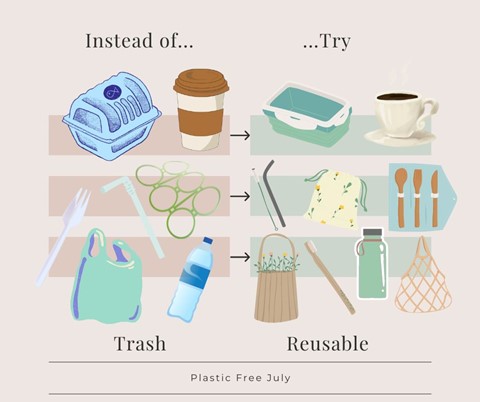By SLCgreen Intern Kellen Hunnicutt

We live in a world that loves plastic. From grocery stores to coffee shops to our bathroom sinks, we see plastic pretty much everywhere. It makes sense. Plastic is lightweight, cheap, durable, and malleable, and in many cases, it serves an instrumental purpose. It keeps our food clean and safe from contamination, is ubiquitous in hospitals and clinics, enables home insulation and energy efficiency, and reduces the weight of cars, which saves gas.
The problem is not these long-lasting or health safety-related uses of plastic. The problem is that we make and use a remarkable amount of unnecessary single-use plastic. Single-use plastics are items like bottled water, plastic grocery bags, and coffee cups that we throw out after only one use.
In 2018 alone, the United States produced 35.7 million tons of plastic, 14.53 million tons of which was packaging. This plastic can end up in oceans, other waterways, streets, or other natural places it doesn’t belong, and it takes lifetimes to decompose. Single-use plastic can pose a particular problem in developing countries that do not have mature waste management systems to properly recycle or dispose of it.
The five biggest contributors to single-use plastic waste are food containers, bottle caps, plastic bags, straws, and bottles/cans.
So, let’s reduce our plastic use!

Plastic Free July began as a small project in Australia but has grown into an international movement of millions of people committed to removing single-use plastics from their lives to end plastic pollution. This July, you can participate in this global movement in several ways. Here are some ideas on what you can do reduce your plastic use:
- Use reusable containers when getting takeout, packing a lunch, or bringing home leftovers. If you’re hosting an event, consider asking guests to bring containers to take leftovers home in.
- Buy your groceries and home goods in bulk and bring your own reusable containers. Try it out at Hello! Bulk Market, Sprouts, or even at Winco. For refills on hygiene, cleaning, or laundry supplies, check out Fosters Refillery delivery service, or Animalia’s Bulk Refill Dispensery.
- Bring reusable bags when shopping.
- Bring a reusable water bottle with you to keep hydrated.
- Keep reusable cutlery with you to use at fast-food joints.
- Refuse plastic straws – you can purchase a reusable straw or go strawless.
- Buy or make beeswax wraps to replace plastic wrap or tinfoil use.
- Perhaps the best way to reduce plastic usage is to reduce how much plastic you buy! When about to purchase a new item, question if it is worth any potential environmental harm.

Sometimes it can feel like there is nothing we can do to stop industries from producing plastic waste. However, all businesses cater to consumers. If we stop supporting plastic packaging, producers will notice and make a change. By reducing your single-use plastics, you are sending a message to big companies showing that you care for the environment and want to see eco-friendly packaging solutions!
By making a simple change to your lifestyle and lessening plastic usage, you are helping to reduce pollution and mitigate climate change. Please take part in Plastic Free July and invite your friends! For more information and resources, visit plasticfreejuly.org.
And if you do have plastic containers to recycle, visit this webpage to learn what’s accepted in the Salt Lake City blue bins!
Let us know: How are you reducing plastic this month?
